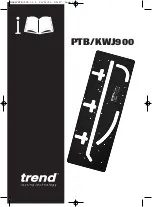
30
30
Between two Cutters
The advantage of this setup is that you can make two
profile cuts in a single pass so it is frequently used when
both edges of the workpiece are to be shaped.
The disadvantage with this method, like the “Below the
Cutter” method, is that any accidental lifting of the
workpiece will cause gouging and ruin the workpiece.
Counter clock Wise Setup
With the cutter installed as shown, feed the workpiece
from right-to-left.
Clock Wise Setup
With the cutter installed as shown, feed the workpiece
from left-to-right.
Grain Direction
Plan to shape the work piece in the same direction as the grain when possible. Some open
grain woods (such as redwood, fir, and oak) will leave a rough, or slightly splintered edge when
cut against the grain.
DANGER:
Deep cuts require excessive horsepower and pushing force to control the cut. Deep
cuts can also cause the wood to splinter or split and may lead to lost control or
personal injury.
Pre-cut the stock on the band saw whenever possible to 1/16" of finished size. When
an edge finish is unsatisfactory. Take two or more cuts with the final cut no more
than 1/16" deep.
In the case of shaping across the grain, the trailing board edge will often splinter. To
correct this, the best solution is to make the board 1/4" oversize in width, shape the
board, and simply trim off the excess material.
Summary of Contents for SS-2725
Page 47: ...44 44 CABINET PARTS DIAGRAM...
Page 48: ...45 45 MOTOR AND QUILL PARTS DIAGRAM...
Page 49: ...46 46 SPINDLE PARTS DIAGRAM...
Page 50: ...47 47 FENCE AND HOOD PARTS DIAGRAM...
Page 55: ...52 52 NOTES...















































